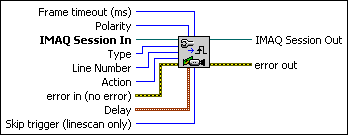IMAQ Configure Trigger3 VI
Installed With: NI Vision Acquisition SoftwareConfigures the trigger conditions for an acquisition. Use this VI before any acquisition VI to setup a triggered image acquisition.

 |
Frame timeout (ms) specifies the amount of time in milliseconds that NI-IMAQ waits for the trigger to occur and an image to be captured. |
||||||||||||||
 |
Polarity specifies the polarity of the trigger signal. The following values are valid.
|
||||||||||||||
 |
IMAQ Session In identifies the device. |
||||||||||||||
 |
Type specifies the type of the trigger signal. The following values are valid.
|
||||||||||||||
 |
Line Number specifies the number of the trigger. |
||||||||||||||
 |
Action specifies if an assertion edge of this trigger line should start an acquisition. The following values are valid:
|
||||||||||||||
 |
error in (no error) describes error conditions that occur before this VI or function runs. The default is no error. If an error occurred before this VI or function runs, the VI or function passes the error in value to error out. This VI or function runs normally only if no error occurred before this VI or function runs. If an error occurs while this VI or function runs, it runs normally and sets its own error status in error out. Use the Simple Error Handler or General Error Handler VIs to display the description of the error code. Use error in and error out to check errors and to specify execution order by wiring error out from one node to error in of the next node.
|
||||||||||||||
 |
Delayspecifies how long the active edge of the Trigger is delayed from the point when the Trigger is asserted.
|
||||||||||||||
 |
Skip trigger (linescan only) is the number of triggers to skip before acquiring a new line. This feature is useful when using an encoder to trigger lines. For example, you may have an encoder that outputs 1,000 ticks per revolution. If you need only 200 lines per revolution, set Skip trigger to 4.
|
||||||||||||||
 |
IMAQ Session Out has the same value as IMAQ Session In. |
||||||||||||||
 |
error out contains error information. If error in indicates that an error occurred before this VI or function ran, error out contains the same error information. Otherwise, it describes the error status that this VI or function produces. Right-click the error out indicator on the front panel and select Explain Error from the shortcut menu for more information about the error.
|







